#gabriel de lorges
Text

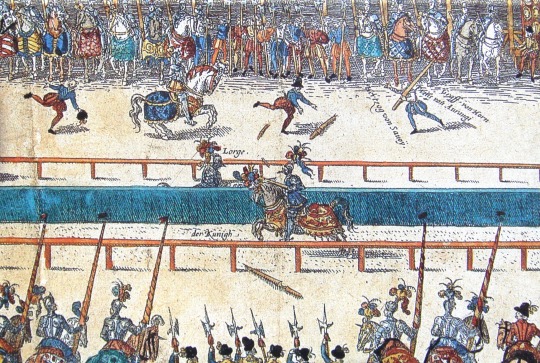
Henry II of France mortally wounded - The Fatal Tournament between Henry II and Count of Montgomery (Lord of Lorges)
by Frans Hogenberg
#tournament#jousting tournament#death#henri ii#henry ii#king#france#french#gabriel de lorges#count of mongomery#scottish#art#frans hogenberg#renaissance#middle ages#medieval#knights#knight#armour#joust#jousting#lance#history#europe#european#montgommery
76 notes
·
View notes
Text

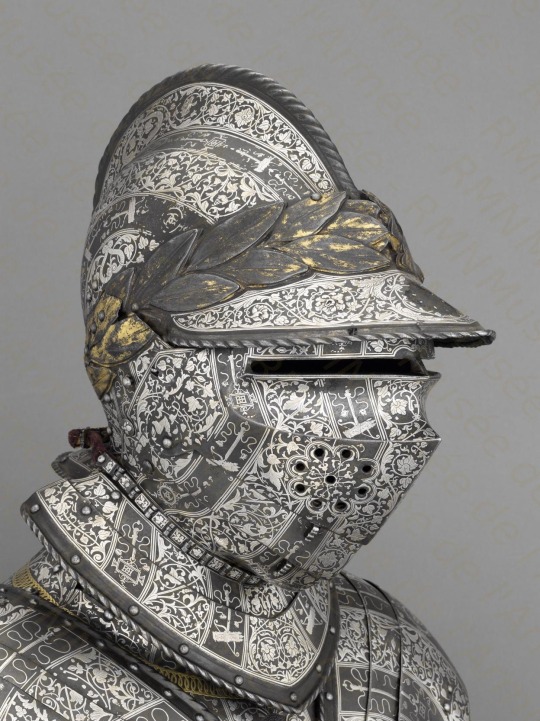
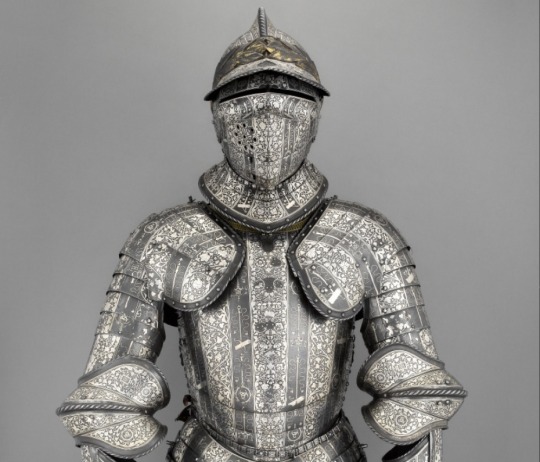
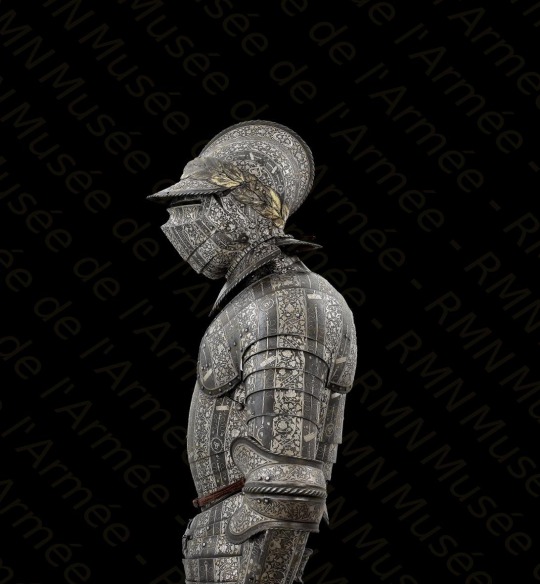

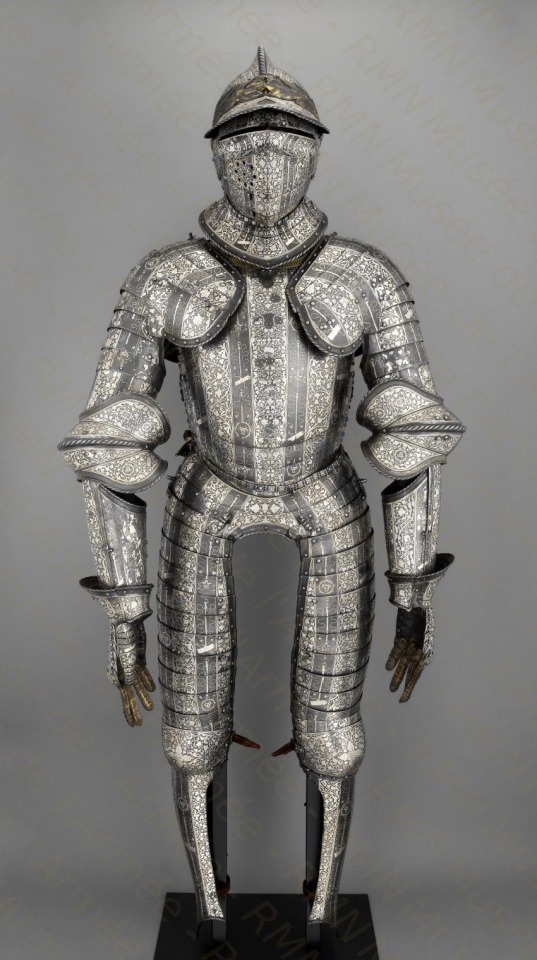
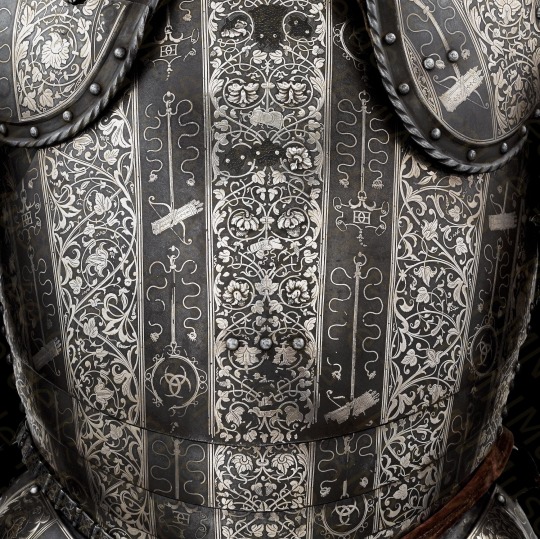



⚜️ Armor of Henry, the future King Henry II of France, made by Negroli Francesco in Milan in the 1540s.
The height of the armor on the stand is 180 cm, width - 90 cm, depth - 50 cm
Weight - 19.7 kg
The weight of the bourguignot is 3.2 kg
Technique: engraving, silvering, blackening, gilding, embossing
Interesting Fact:
Henry II was an avid hunter and a participant in jousts and tournaments. In 1559 during a jousting match, King Henry was wounded in the eye by a fragment of the splintered lance of Gabriel de Lorges, Count of Montgomery. Despite the efforts of royal surgeons, the king's untreated eye and brain damage led to his death by sepsis. Henry's death played a significant role in the decline of jousting as a sport, particularly in France.
⠀
🏛 Musée de l'Armée, France
№ 1011 I (G 118 ROB)
⠀
- -
⚜️ Доспех дофина, будущего короля Франции Генриха II, около 1540 г.
Изготовлен миланским оружейником Франческо Негроли
Высота доспеха на подставке - 180 см, ширина - 90 см, глубина - 50 см
Вес - 19,7 кг
Вес бургиньота - 3,2 кг
Техника: гравировка, серебрение, чернение, золочение, чеканка
⠀
Факт:
Генрих II был заядлым охотником и участником рыцарских турниров. В 1559 году во время рыцарского поединка король Генрих был ранен в глаз осколком копья графа Габриэля Монтгомери. Смерть Генриха сыграла значительную роль в упадке джостинга (рыцарского спорта), особенно во Франции.
⠀
События, связанные с гибелью Генриха II, живописно описаны в двух романах Александра Дюма «Две Дианы» и «Паж герцога Савойского».
⠀
🏛 Парижский Музей Армии (Musée de l'Armée)
Инв. № 1011 I (G 118 ROB)
⠀
#гравировка #серебрение #чернение #золочение #чеканка #knight #armour #medievalarmour #armsandarmor #history #ГенрихII #МузейАрмии #HenryII #engraving #silvering #blackening #gilding #embossing
122 notes
·
View notes
Text
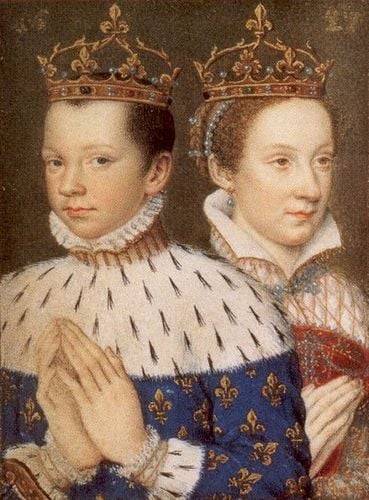
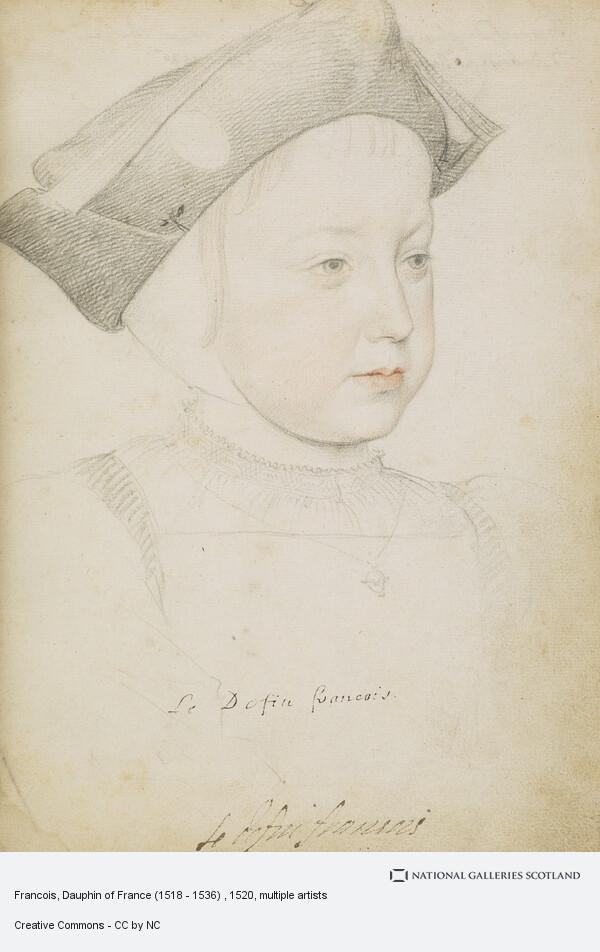

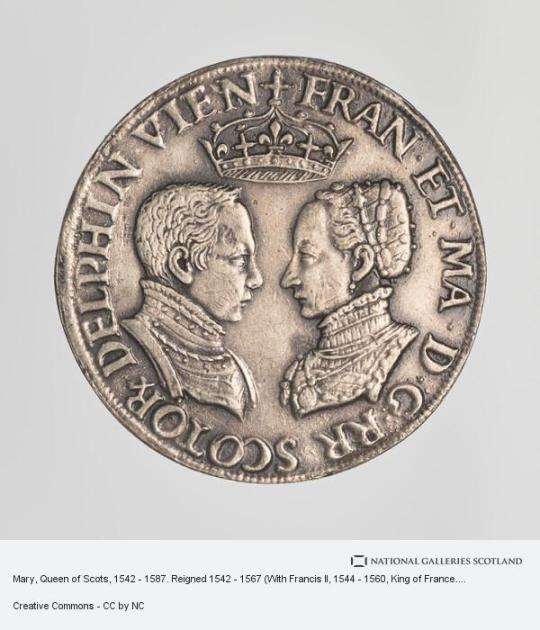
On December 5th 1560 King Francis II of France, the husband of Mary Queen of Scots, died.
Although not crowned it has to be remembered that Francis was also King consort of Scotland.
Francis was born on 19 January 1544, the eldest son of Henry II of France and Catherine de Medici, he was named for his grandfather, King Francis I.
When Francis was four years old, the Scots and French signed the Treaty of Haddington in July 1548 arranging the betrothal of Mary Queen of Scots and the dauphin Francis in return for French aid to expel the invading English. Mary Queen of Scots sailed from Dumbarton for France in the August of 1548 when she was but five years old. The young Queen was accompanied by her four Marys, the daughters of Scottish noble families, Mary Beaton, Mary Seton, Mary Fleming and Mary Livingston.
Mary spent the rest of her childhood at the court of her father-in-law, Henri II Her father-in-law, Henry II of France wrote 'from the very first day they met, my son and she got on as well together as if they had known each other for a long time'. Mary was a pretty child and brought up in the same nursery as her future husband and his siblings, became very attached to him. She corresponded regularly Mary of Guise , who remained in Scotland to rule as regent for her daughter. Much of her early life was spent at Château de Chambord. She was educated at the French court learning French, Latin, Greek, Spanish and Italian and enjoyed falconry, needlework, poetry, prose, horse riding and playing musical instruments.
Mary was the cosseted darling of the French court, the doting Henri II wrote 'The little Queen of Scots is the most perfect child I have ever seen.' He corresponded frequently with Mary of Guise, expressing his delight in his young daughter-in-law. Mary's maternal grandmother, Antoinette of Guise, in a letter to her daughter in Scotland, stated that she found Mary ' very pretty, graceful and self assured.'
Francis and Mary were married with spectacular pageantry and magnificence in the cathedral of Notre Dame, Paris, by the Cardinal Archbishop of Rouen, in the presence of Henry II, Queen Catherine de' Medici and a glittering throng of cardinals and nobles. The French courtier Pierre de Brantôme described Mary as ‘a hundred times more beautiful than a goddess of heaven … her person alone was worth a kingdom.’
Among the wedding guests was one, James Hepburn Earl of Bothwell. Francis was fourteen and Mary fifteen at the time, Francis then held the title King consort of Scotland until his death.
When Henri II was killed during a jousting contest, incidentally by Gabriel de Lorges, Comte de Montgomery, Captain of The Scots Guard, and a descendant of Alexander Montgomerie of Auchterhouse, Mary's young husband Francois ascended the throne. Francis was reported to have found the crown of France so heavy that the nobles were obliged to hold it in place for him.
The young Francis became a tool of Mary's maternal relations, the ambitious Guise family, who seized the chance for power and hoped to crush the Huguenots in France. The Huguenot leader, Louis de Bourbon, prince de Condé plotted the conspiracy of Amboise in March 1560, an abortive coup d'etat in which Huguenots surrounded the Château of Amboise and attempted to seize the King. The conspiracy was savagely put down, and its failure led to increase the power of the Guises. This alarmed the king 's mother, Catherine de Medici, who reacted by attempting to secure the appointment of the moderate Michel de L'Hospital as chancellor.
During the autumn of 1560 François became increasingly ill, and died from the complications of an ear condition, in Orléans, Loiret. Since the marriage had borne no children, the French throne passed to his 10-year-old brother, Charles IX. Mary was said to be grief-stricken Multiple diseases have been suggested as the cause of Francis' death, such as mastoiditis, meningitis, or otitis exacerbated into an abscess. Francis was buried in the Basilica of St Denis.
There was no place for the seventeen year old Mary, Queen of Scots in France, she prepared to return to her native Scotland with an uncertain future that would hold.
16 notes
·
View notes
Text
Seachtain a 7, dar deireadh 17/02
Noah Buffini Higgs a d'aistrigh
Bunleagan Béarla Dhave McGinn ar fáil anseo
Éirí As Nicola Sturgeon
D'fhógair Céad-Aire na hAlban Nicola Sturgeon éirí as a poist tar éis 8 mbliana. Fógraíodh gan choinne go raibh an ceannaire is faide i bhfeighil ar an tír - agus an chéad cheannaire mná - ag éirí as ag preasócáid Dé Céadaoin.
Cioclón i dTuaisceart na Nua-Shéalainne
Maraíodh ceathrar ar a laghad de bharr an chioclóin is measa a bhuail an Nua-Shéalainn le blianta fada anuas. Bhí páiste mar duine den chéad cheathrar a aithníodh a fuair bás de bharr Cioclón Gabrielle, a bhí mar chúis le scriosadh fairsing i dTuaisceart na tíre.
4 Rud ar Snámh san Aer thar na SAM
Tá arm na Stát Aontaithe tar éis ceithre réad a thabhairt go talamh a bhí ar snámh go hard san aer os cionn Meiriceá Thuaidh le seachtain anuas. Tugadh réad anaithnid go talamh thar Loch Huron Dé Sathairn, ag teacht ar lorg roinnt cinn eile agus ceann acu á maíomh gur balún faire de chuid na Síne é.
Prótacal Tuaiscirt na hÉireann
Tá dóchas ann go ndéanfar socrú idir an Ríocht Aontaithe agus an tAontas Eorpach i leith na Breatimeachta agus Prótacal an Tuaiscirt. Luaigh ceannaire an DUP Jeffrey Donaldson go bhfuiltear ag dul chun cinn, ach thug sé an rabhadh chomh maith go bhfuil obair fágtha go fóill.
#news#irish#bilingual#update#current events#northern ireland#northern ireland protocol#tuaisceart#scotland#nicola sturgeon#cyclone#new zealand#DUP#Jeffrey Donaldson
0 notes
Photo
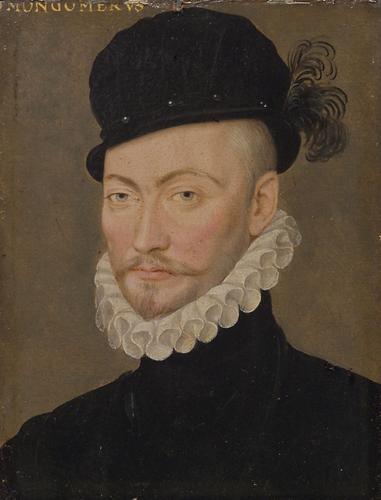
Gabriel de Lorges comte de Montgomery (1530-1574), Anonymous, Kunsthistorisches Museum, Vienna.
27 notes
·
View notes
Text
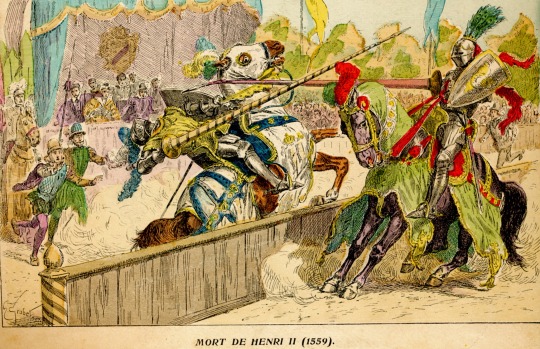
The Death of Henry II (1559)
by Henri Grobet
#henri ii#king#france#count of montgomery#art#henri grobet#gabriel de lorges#nobleman#henry ii#history#jousting#jousting tournament#joust#tournament#europe#european#knights#lance#medieval#renaissance#middle ages#knight#combat#single combat
67 notes
·
View notes
Photo
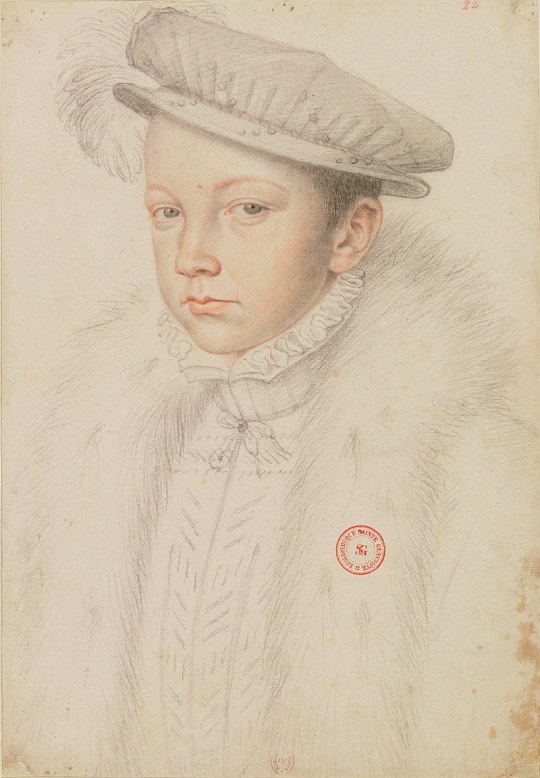

On December 5th 1560 King Francis II of France, the husband of Mary Queen of Scots, died.
Although not crowned it has to be remembered that Francis was also King consort of Scotland.
Francis was born on 19th January 1544, the eldest son of Henry II of France and Catherine de Medici, he was named for his grandfather, King Francis I.
When Francis was four years old, the Scots and French signed the Treaty of Haddington in July 1548 arranging the betrothal of Mary Queen of Scots and the dauphin Francis in return for French aid to expel the invading English. Mary Queen of Scots sailed from Dumbarton for France in the August of 1548 when she was but five years old. The young Queen was accompanied by her four Marys, the daughters of Scottish noble families, Mary Beaton, Mary Seton, Mary Fleming and Mary Livingston.
Mary spent the rest of her childhood at the court of her father-in-law, Henri II Her father-in-law, Henry II of France wrote ‘from the very first day they met, my son and she got on as well together as if they had known each other for a long time’. Mary was a pretty child and brought up in the same nursery as her future husband and his siblings, became very attached to him. She corresponded regularly Mary of Guise , who remained in Scotland to rule as regent for her daughter. Much of her early life was spent at Château de Chambord. She was educated at the French court learning French, Latin, Greek, Spanish and Italian and enjoyed falconry, needlework, poetry, prose, horse riding and playing musical instruments.
Mary was the cosseted darling of the French court, the doting Henri II wrote 'The little Queen of Scots is the most perfect child I have ever seen.’ He corresponded frequently with Mary of Guise, expressing his delight in his young daughter-in-law. Mary’s maternal grandmother, Antoinette of Guise, in a letter to her daughter in Scotland, stated that she found Mary ’ very pretty, graceful and self assured.’
Francis and Mary were married with spectacular pageantry and magnificence in the cathedral of Notre Dame, Paris, by the Cardinal Archbishop of Rouen, in the presence of Henry II, Queen Catherine de’ Medici and a glittering throng of cardinals and nobles. The French courtier Pierre de Brantôme described Mary as ‘a hundred times more beautiful than a goddess of heaven … her person alone was worth a kingdom.’
Among the wedding guests was one, James Hepburn Earl of Bothwell. Francis was fourteen and Mary fifteen at the time, Francis then held the title King consort of Scotland until his death.
When Henri II was killed during a jousting contest, incidentally by Gabriel de Lorges, Comte de Montgomery, Captain of The Scots Guard, and a descendant of Alexander Montgomerie of Auchterhouse, Mary’s young husband Francois ascended the throne. Francis was reported to have found the crown of France so heavy that the nobles were obliged to hold it in place for him.
The young Francis became a tool of Mary’s maternal relations, the ambitious Guise family, who seized the chance for power and hoped to crush the Huguenots in France. The Huguenot leader, Louis de Bourbon, prince de Condé plotted the conspiracy of Amboise in March 1560, an abortive coup d'etat in which Huguenots surrounded the Château of Amboise and attempted to seize the King. The conspiracy was savagely put down, and its failure led to increase the power of the Guises. This alarmed the king ’s mother, Catherine de Medici, who reacted by attempting to secure the appointment of the moderate Michel de L'Hospital as chancellor.
During the autumn of 1560 François became increasingly ill, and died from the complications of an ear condition, in Orléans, Loiret. Since the marriage had borne no children, the French throne passed to his 10-year-old brother, Charles IX. Mary was said to be grief-stricken Multiple diseases have been suggested as the cause of Francis’ death, such as mastoiditis, meningitis, or otitis exacerbated into an abscess. Francis was buried in the Basilica of St Denis.
There was no place for the seventeen year old Mary, Queen of Scots in France, she prepared to return to her native Scotland with an uncertain future that would hold.
35 notes
·
View notes
Text


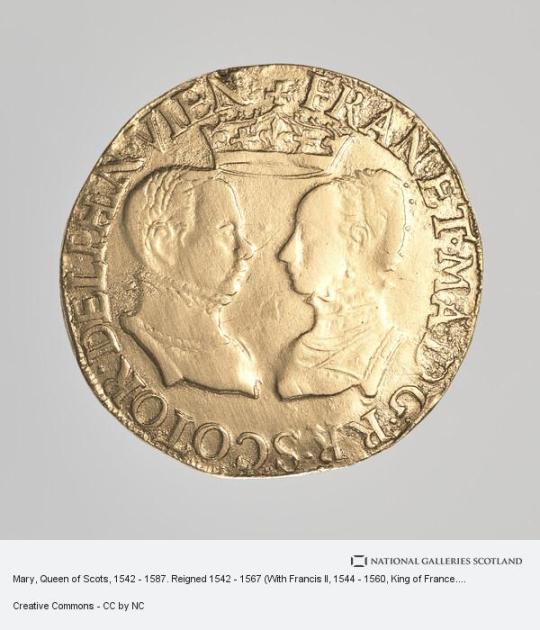
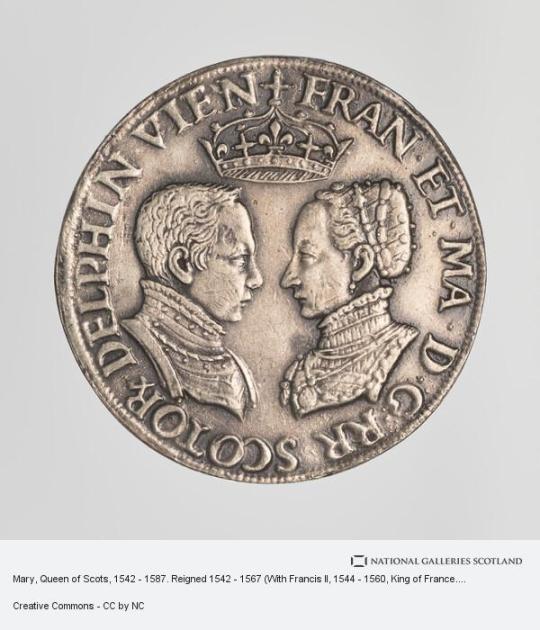
On December 5th 1560 King Francis II of France, the husband of Mary Queen of Scots, died.
Although not crowned it has to be remembered that Francis was also King consort of Scotland.
Francis was born on 19 January 1544, the eldest son of Henry II of France and Catherine de Medici, he was named for his grandfather, King Francis I.
When Francis was four years old, the Scots and French signed the Treaty of Haddington in July 1548 arranging the betrothal of Mary Queen of Scots and the dauphin Francis in return for French aid to expel the invading English. Mary Queen of Scots sailed from Dumbarton for France in the August of 1548 when she was but five years old. The young Queen was accompanied by her four Marys, the daughters of Scottish noble families, Mary Beaton, Mary Seton, Mary Fleming and Mary Livingston.
Mary spent the rest of her childhood at the court of her father-in-law, Henri II Her father-in-law, Henry II of France wrote 'from the very first day they met, my son and she got on as well together as if they had known each other for a long time'. Mary was a pretty child and brought up in the same nursery as her future husband and his siblings, became very attached to him. She corresponded regularly Mary of Guise , who remained in Scotland to rule as regent for her daughter. Much of her early life was spent at Château de Chambord. She was educated at the French court learning French, Latin, Greek, Spanish and Italian and enjoyed falconry, needlework, poetry, prose, horse riding and playing musical instruments.
Mary was the cosseted darling of the French court, the doting Henri II wrote 'The little Queen of Scots is the most perfect child I have ever seen.' He corresponded frequently with Mary of Guise, expressing his delight in his young daughter-in-law. Mary's maternal grandmother, Antoinette of Guise, in a letter to her daughter in Scotland, stated that she found Mary ' very pretty, graceful and self assured.'
Francis and Mary were married with spectacular pageantry and magnificence in the cathedral of Notre Dame, Paris, by the Cardinal Archbishop of Rouen, in the presence of Henry II, Queen Catherine de' Medici and a glittering throng of cardinals and nobles. The French courtier Pierre de Brantôme described Mary as ‘a hundred times more beautiful than a goddess of heaven … her person alone was worth a kingdom.’
Among the wedding guests was one, James Hepburn Earl of Bothwell. Francis was fourteen and Mary fifteen at the time, Francis then held the title King consort of Scotland until his death.
When Henri II was killed during a jousting contest, incidentally by Gabriel de Lorges, Comte de Montgomery, Captain of The Scots Guard, and a descendant of Alexander Montgomerie of Auchterhouse, Mary's young husband Francois ascended the throne. Francis was reported to have found the crown of France so heavy that the nobles were obliged to hold it in place for him.
The young Francis became a tool of Mary's maternal relations, the ambitious Guise family, who seized the chance for power and hoped to crush the Huguenots in France. The Huguenot leader, Louis de Bourbon, prince de Condé plotted the conspiracy of Amboise in March 1560, an abortive coup d'etat in which Huguenots surrounded the Château of Amboise and attempted to seize the King. The conspiracy was savagely put down, and its failure led to increase the power of the Guises. This alarmed the king 's mother, Catherine de Medici, who reacted by attempting to secure the appointment of the moderate Michel de L'Hospital as chancellor.
During the autumn of 1560 François became increasingly ill, and died from the complications of an ear condition, in Orléans, Loiret. Since the marriage had borne no children, the French throne passed to his 10-year-old brother, Charles IX. Mary was said to be grief-stricken Multiple diseases have been suggested as the cause of Francis' death, such as mastoiditis, meningitis, or otitis exacerbated into an abscess. Francis was buried in the Basilica of St Denis.
There was no place for the seventeen year old Mary, Queen of Scots in France, she prepared to return to her native Scotland with an uncertain future that would hold.
4 notes
·
View notes
Text

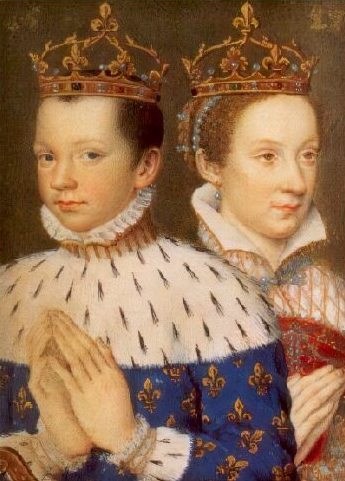
On December 5th 1560 King Francis II of France, the husband of Mary Queen of Scots, died.
Although not crowned it has to be remembered that Francis was also King consort of Scotland.
Francis was born on 19 January 1544, the eldest son of Henry II of France and Catherine de Medici, he was named for his grandfather, King Francis I.
When Francis was four years old, the Scots and French signed the Treaty of Haddington in July 1548 arranging the betrothal of Mary Queen of Scots and the dauphin Francis in return for French aid to expel the invading English. Mary Queen of Scots sailed from Dumbarton for France in the August of 1548 when she was but five years old. The young Queen was accompanied by her four Marys, the daughters of Scottish noble families, Mary Beaton, Mary Seton, Mary Fleming and Mary Livingston.
Mary spent the rest of her childhood at the court of her father-in-law, Henri II Her father-in-law, Henry II of France wrote 'from the very first day they met, my son and she got on as well together as if they had known each other for a long time'. Mary was a pretty child and brought up in the same nursery as her future husband and his siblings, became very attached to him. She corresponded regularly Mary of Guise , who remained in Scotland to rule as regent for her daughter. Much of her early life was spent at Château de Chambord. She was educated at the French court learning French, Latin, Greek, Spanish and Italian and enjoyed falconry, needlework, poetry, prose, horse riding and playing musical instruments.
Mary was the cosseted darling of the French court, the doting Henri II wrote 'The little Queen of Scots is the most perfect child I have ever seen.' He corresponded frequently with Mary of Guise, expressing his delight in his young daughter-in-law. Mary's maternal grandmother, Antoinette of Guise, in a letter to her daughter in Scotland, stated that she found Mary ' very pretty, graceful and self assured.'
Francis and Mary were married with spectacular pageantry and magnificence in the cathedral of Notre Dame, Paris, by the Cardinal Archbishop of Rouen, in the presence of Henry II, Queen Catherine de' Medici and a glittering throng of cardinals and nobles. The French courtier Pierre de Brantôme described Mary as ‘a hundred times more beautiful than a goddess of heaven … her person alone was worth a kingdom.’
Among the wedding guests was one, James Hepburn Earl of Bothwell. Francis was fourteen and Mary fifteen at the time, Francis then held the title King consort of Scotland until his death.
When Henri II was killed during a jousting contest, incidentally by Gabriel de Lorges, Comte de Montgomery, Captain of The Scots Guard, and a descendant of Alexander Montgomerie of Auchterhouse, Mary's young husband Francois ascended the throne. Francis was reported to have found the crown of France so heavy that the nobles were obliged to hold it in place for him.
The young Francis became a tool of Mary's maternal relations, the ambitious Guise family, who seized the chance for power and hoped to crush the Huguenots in France. The Huguenot leader, Louis de Bourbon, prince de Condé plotted the conspiracy of Amboise in March 1560, an abortive coup d'etat in which Huguenots surrounded the Château of Amboise and attempted to seize the King. The conspiracy was savagely put down, and its failure led to increase the power of the Guises. This alarmed the king 's mother, Catherine de Medici, who reacted by attempting to secure the appointment of the moderate Michel de L'Hospital as chancellor.
During the autumn of 1560 François became increasingly ill, and died from the complications of an ear condition, in Orléans, Loiret. Since the marriage had borne no children, the French throne passed to his 10-year-old brother, Charles IX. Mary was said to be grief-stricken Multiple diseases have been suggested as the cause of Francis' death, such as mastoiditis, meningitis, or otitis exacerbated into an abscess. Francis was buried in the Basilica of St Denis.
17 notes
·
View notes
Photo

On July 10th 1559 King Henry II of France died from an injury received during a jousting tournament.
This ties in with Scotland in two instances.
If you remember my post on Gabriel de Lorges, Count of Montgomery two weeks ago, he was a French nobleman of Scottish extraction and captain of the Scots Guard of King Henry II, it’s him that is on the right, with the broken lance in the depiction.
On 30th June 1559, the king was jousting against Montgomery, even though King Henry was properly armoured for the tournament, when Montgomery’s lance hit him on the helmet, a long splinter from the shattered lance slipped through the slits of the king’s visor and pierced the king’s eye. Reportedly, the sliver of wood was driven in so deeply it actually penetrated his brain.
The audience and court were horrified by the disaster. King Henri was taken back to the Hôtel des Tournelles, where he lay in ever-increasing agony for more than a week.
Two of the most renown physicians in Europe, Andreas Vesalius and Ambroise Paré, did everything they could to save the wounded monarch, but there was almost nothing the early modern doctors could do about infection.
King Henri of France died, probably of septicaemia on this day in 1559.
The second instance with a Scottish connection was Henry’s son became François II of France, and his wife Mary Stuart, Queen.
Tragically, King Francis II died after only a year and 1/2 on the throne, Mary was of no use to the French as such, so she was sent pacing back to Scotland which had just gone through the turmoil of the Reformation, it was never going to be easy for the young devout Catholic Queen in her native land.
22 notes
·
View notes
Text

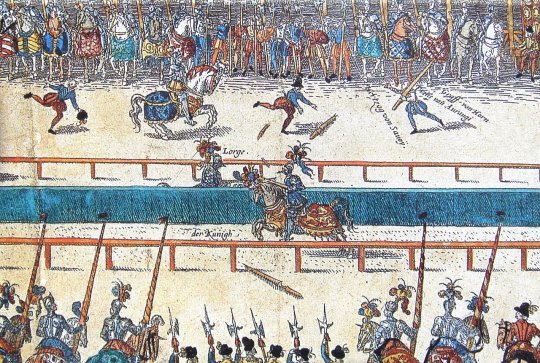
On June 26th 1574, Gabriel de Lorges was beheaded in Paris for treason.
A wee tenuous one this but it has a couple of links to Scotland so it's enough to make a post about him. Also check out the link at the bottom of the post for details of how to go see a jousting event at Linlithgow Palace this weekend.
Known by the time of his death as the Comte de Montgomery , he had been a Captain of The Garde Écossaise, The Scots Guards an elite Scottish military unit who were bodyguards to the French Monarchy.
Gabriel was born in Ducey, France, the son of Jacques, Duke of Montgomery, a Scottish nobleman with a sound career supporting the kings of France
To rewind a wee bit to to 1559, during a jousting contest was pitted against the Sporty French King, Henry II, his shattered lance somehow found a chink in the king’s visor and managed to catch the royal jouster just beside the eye. After a week and a half in agony, Henri succumbed to the injury and left this mortal coil. While Henry absolved Montgomery of any blame while on his deathbed finding himself disgraced, Montgomery retreated to his estates in Normandy and hurled himself into study that soon converted him to the Protestant faith.
At the time France was in a struggle Huguenots, a Protestant faction who followed in the Calvinist traditions of the Reformation that was sweeping through Europe at the time. Montgomery through himself into the struggle and was appointed a commander quickly distinguishing himself as perhaps the ablest of the soldiers fighting the cause.
Gabriel was in Paris in 1572 during an ostensible truce for interparty dynastic nuptials when the Catholic faction sprang the St. Bartholomew’s Day massacre upon The Huguenots. Though Montgomery was a specific target for assassination that day, he somehow managed to escape. He gave the Catholics fits for the two years left him, enough that the crown tried to buy him off. (Like most Protestants, he was distrustfully defiant after the horrors of St. Bartholomew’s Day.) He fled to England for a time and the Medici’s asked for his extradition in 1573 but Elizabeth I refused, the following year he was captured after trying to start a revolt in Normandy, taken to Paris and sentenced to be beheaded. Gabriel refused to confess his sins or receive a catholic priest’s last rights.
In front of a partisan Catholic crowd baying for blood he was led out to meet his end in Paris, a royal edict was read to him; his land was to be confiscated and his children would not inherit his titles. Still unbowed Gabriel shouted
“tell my children, if they are not able to reclaim their position, I curse them from the grave!”
The blade of the guillotine dropped and his head was off, seemingly spraying his son with blood as he stood below the platform.
The story is told in the Alexandre Dumas book, The Two Diana’s. You can find a more in-depth account of the story here
https://www.normandythenandnow.com/the-heroic-end-of-gabriel-comte-de-montgomery-in-domfront/
5 notes
·
View notes
Text

watch your step, noble courtier, you’ve been summoned to hampton court palace by his majesty’s decree & pleasure. please hasten to send your blog in, and review our checklist (and introductory sheet) prior to beginning interactions.
steven yeun as gabriel de lorges, count of montgomery
3 notes
·
View notes
Photo


On June 26th 1574, Gabriel de Lorges was beheaded in Paris for treason.
A wee tenuous one this but it has a couple of links to Scotland so it's enough to make a post about him.
Known by the time of his death as the Comte de Montgomery , he had been a Captain of The Garde Écossaise, The Scots Guards an elite Scottish military unit who were bodyguards to the French Monarchy.
Gabriel was born in Ducey, France, the son of Jacques, Duke of Montgomery, a Scottish nobleman with a sound career supporting the kings of France
To rewind a wee bit to to 1559, during a jousting contest was pitted against the Sporty French King, Henry II, his shattered lance somehow found a chink in the king’s visor and managed to catch the royal jouster just beside the eye. After a week and a half in agony, Henri succumbed to the injury and left this mortal coil. While Henry absolved Montgomery of any blame while on his deathbed finding himself disgraced, Montgomery retreated to his estates in Normandy and hurled himself into study that soon converted him to the Protestant faith.
At the time France was in a struggle Huguenots, a Protestant faction who followed in the Calvinist traditions of the Reformation that was sweeping through Europe at the time. Montgomery through himself into the struggle and was appointed a commander quickly distinguishing himself as perhaps the ablest of the soldiers fighting the cause.
Gabriel was in Paris in 1572 during an ostensible truce for interparty dynastic nuptials when the Catholic faction sprang the St. Bartholomew’s Day massacre upon The Huguenots. Though Montgomery was a specific target for assassination that day, he somehow managed to escape. He gave the Catholics fits for the two years left him, enough that the crown tried to buy him off. (Like most Protestants, he was distrustfully defiant after the horrors of St. Bartholomew’s Day.) He fled to England for a time and the Medici’s asked for his extradition in 1573 but Elizabeth I refused, the following year he was captured after trying to start a revolt in Normandy, taken to Paris and sentenced to be beheaded. Gabriel refused to confess his sins or receive a catholic priest’s last rights.
In front of a partisan Catholic crowd baying for blood he was led out to meet his end in Paris, a royal edict was read to him; his land was to be confiscated and his children would not inherit his titles. Still unbowed Gabriel shouted
“tell my children, if they are not able to reclaim their position, I curse them from the grave!”
The blade of the guillotine dropped and his head was off, seemingly spraying his son with blood as he stood below the platform.
The story is told in the Alexandre Dumas book, The Two Diana’s. You can find a more in-depth account of the story here
https://www.normandythenandnow.com/the-heroic-end-of-gabriel-comte-de-montgomery-in-domfront/
11 notes
·
View notes
Photo


On December 5th 1560 King Francis II of France, the husband of Mary Queen of Scots, died.
Francis II of France was the eldest son of King Henry II and Catherine de’ Medici. He was a sickly child with stunted growth. His father got him betrothed to Mary, Queen of Scots, when he was 4 years old. This gave him the right to the throne of Scotland and assured the Scots protection of the French against the English.
They got married at the age of 14, the marriage also meant he was King Consort of Scotland, he became the king of France at 15, when his father died in a jousting accident, incidentally involving a Frenchman of Scottish descent, Gabriel de Lorges, 1st Earl of Montgomery.
Francis II died in Orléans due to multiple medical complications, having reigned for just 17 months. Since he had no children, his younger brother, Charles, succeeded him as the king of France, and Mary returned to Scotland.
28 notes
·
View notes
Photo
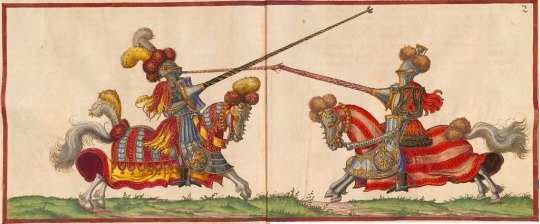


On July 10th 1559 King Henry II of France died from an injury received during a jousting tournament.
On 30th June 1559, the king was jousting against a French nobleman called Gabriel de Lorges, Count of Montgomery. Gabriel was born in Ducey, France, the son of Jacques, Duke of Montgomery, a Scottish nobleman with a sound career supporting the kings of France, Gabriel grew up in the same vein and he became the captain of The Garde Écossaise (The Scots Guard) an elite Scottish military unit founded in 1418 to be personal bodyguards to the French monarchy.
Even though King Henry was properly armoured for the tournament, when Montgomery’s lance hit him on the helmet, a long splinter from the shattered lance slipped through the slits of the king’s visor and pierced the king’s eye. Reportedly, the sliver of wood was driven in so deeply it actually penetrated his brain. Montgomery hurried to kneel before the king and asked to have his head and hand cut off in punishment, but Henry magnanimously told him that it was not his fault and he had carried himself bravely and well.
The royal doctors removed the splinter from the king’s eye and others that had pierced his head and throat and bled the patient who relapsed into unconsciousness. It was hoped that the loss of the eye was the worst that would happen, but even though the royal surgeon fought to save the king, on July 9th the last rites were administered and the king died early in the afternoon of the following day. He was 40 years old.
Although Henry forgave him on his deathbed, could not cope with his “crime” and resigned his commission, throwing himself into a life of religious study, this soon converted him to the Protestant party and he took up arms against the Catholic authorities of France in a movement called The Huguenots, I’m totally out of my depth here so wont go into the history of this and will just concentrate on our erstwhile “Scot” who became a more than able commander of the Protestant faction, to the point that in an infamous event in Paris in 1572, The St. Bartholomew’s Day massacre in which during a truce, Catholics began assassinating the Huguenot’s hierarchy, lasting several weeks, the massacre expanded outward to other urban centres and the countryside. Modern estimates for the number of dead across France vary widely, from 5,000 to 30,000. Though Montgomery was a specific target for assassination that day, he somehow managed to escape. He gave the Catholics fits for the two years left him, enough that the crown tried to buy him off. (Like most Protestants, he was distrustfully defiant after the horrors of St. Bartholomew’s Day.)
While mounting an insurrection in Normandy, he was finally captured, and was dispatched to Paris, tortured, put on trial and sentenced to death.
On 26th June 1574, as he was about to be beheaded, Montgomery was informed that a royal edict had proclaimed that his property would be confiscated and his children deprived of their titles. In true martyrdom style Gabriel is said to have shouted “tell my children, if they are not able to reclaim their position, I curse them from the grave!”
And then they cut off his head.
If you want to know the complete story there is a great account to be found on the link here http://www.normandythenandnow.com/the-heroic-end-of-gabriel-comte-de-montgomery-in-domfront/
8 notes
·
View notes
Photo

On December 5th 1560 King Francis II of France, the husband of Mary Queen of Scots, died.
Although not crowned it has to be remembered that Francis was also King consort of Scotland.
Francis was born on 19 January 1544, the eldest son of Henry II of France and Catherine de Medici, he was named for his grandfather, King Francis I.
When Francis was four years old, the Scots and French signed the Treaty of Haddington in July 1548 arranging the betrothal of Mary Queen of Scots and the dauphin Francis in return for French aid to expel the invading English. Mary Queen of Scots sailed from Dumbarton for France in the August of 1548 when she was but five years old. The young Queen was accompanied by her four Marys, the daughters of Scottish noble families, Mary Beaton, Mary Seton, Mary Fleming and Mary Livingston.
Mary spent the rest of her childhood at the court of her father-in-law, Henri II Her father-in-law, Henry II of France wrote 'from the very first day they met, my son and she got on as well together as if they had known each other for a long time'. Mary was a pretty child and brought up in the same nursery as her future husband and his siblings, became very attached to him. She corresponded regularly Mary of Guise , who remained in Scotland to rule as regent for her daughter. Much of her early life was spent at Château de Chambord. She was educated at the French court learning French, Latin, Greek, Spanish and Italian and enjoyed falconry, needlework, poetry, prose, horse riding and playing musical instruments.
Mary was the cosseted darling of the French court, the doting Henri II wrote 'The little Queen of Scots is the most perfect child I have ever seen.' He corresponded frequently with Mary of Guise, expressing his delight in his young daughter-in-law. Mary's maternal grandmother, Antoinette of Guise, in a letter to her daughter in Scotland, stated that she found Mary ' very pretty, graceful and self assured.'
Francis and Mary were married with spectacular pageantry and magnificence in the cathedral of Notre Dame, Paris, by the Cardinal Archbishop of Rouen, in the presence of Henry II, Queen Catherine de' Medici and a glittering throng of cardinals and nobles. The French courtier Pierre de Brantôme described Mary as ‘a hundred times more beautiful than a goddess of heaven … her person alone was worth a kingdom.’
Among the wedding guests was one, James Hepburn Earl of Bothwell. Francis was fourteen and Mary fifteen at the time, Francis then held the title King consort of Scotland until his death.
When Henri II was killed during a jousting contest, incidentally by Gabriel de Lorges, Comte de Montgomery, Captain of The Scots Guard, and a descendant of Alexander Montgomerie of Auchterhouse, Mary's young husband Francois ascended the throne. Francis was reported to have found the crown of France so heavy that the nobles were obliged to hold it in place for him.
The young Francis became a tool of Mary's maternal relations, the ambitious Guise family, who seized the chance for power and hoped to crush the Huguenots in France. The Huguenot leader, Louis de Bourbon, prince de Condé plotted the conspiracy of Amboise in March 1560, an abortive coup d'etat in which Huguenots surrounded the Château of Amboise and attempted to seize the King. The conspiracy was savagely put down, and its failure led to increase the power of the Guises. This alarmed the king 's mother, Catherine de Medici, who reacted by attempting to secure the appointment of the moderate Michel de L'Hospital as chancellor.
During the autumn of 1560 François became increasingly ill, and died from the complications of an ear condition, in Orléans, Loiret. Since the marriage had borne no children, the French throne passed to his 10-year-old brother, Charles IX. Mary was said to be grief-stricken Multiple diseases have been suggested as the cause of Francis' death, such as mastoiditis, meningitis, or otitis exacerbated into an abscess. Francis was buried in the Basilica of St Denis.
There was no place for the seventeen year old Mary, Queen of Scots in France, she prepared to return to her native Scotland with an uncertain future that would hold.
30 notes
·
View notes